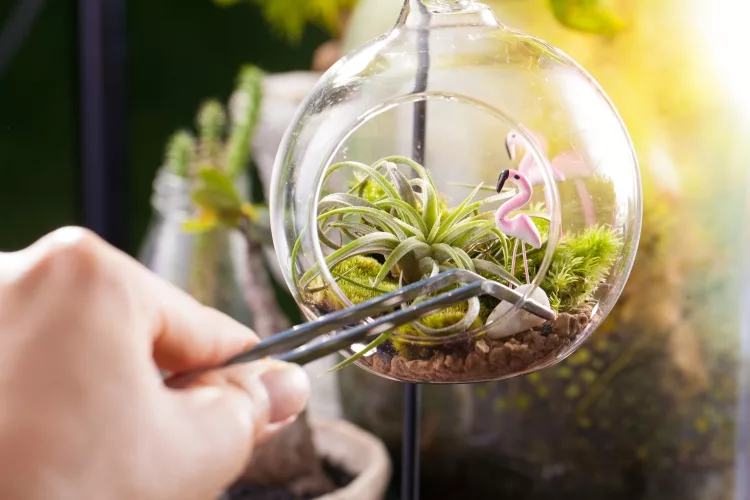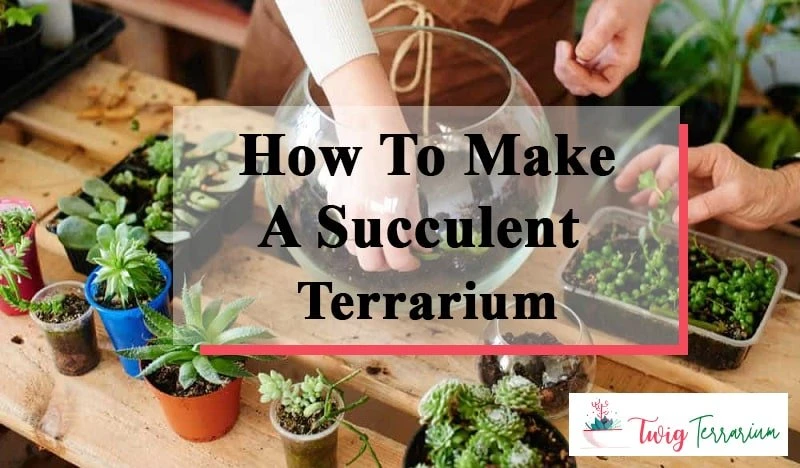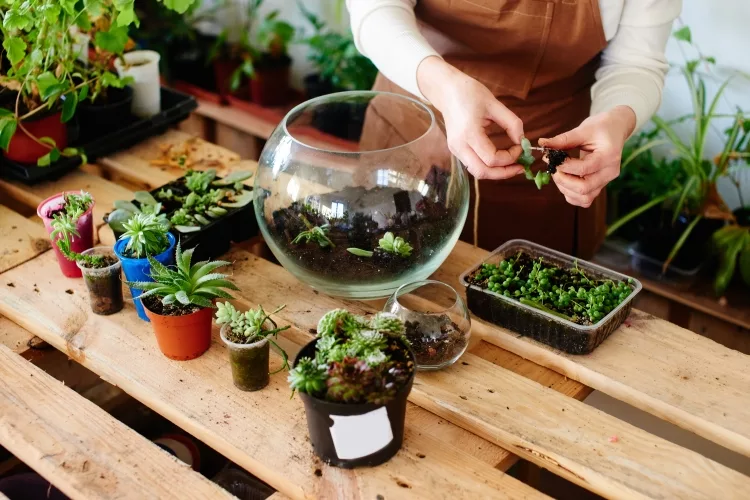reviewed by Christina Lopez
Recently, it has become increasingly common to see beautiful pictures of terrariums with plants on the Internet. Many of them are almost works of art – with a plot, character figures, and tiny copies of objects. Such a thing may seem very complicated in execution and fastidious in care, but it is not so if guided by a few tips. Home terrariums are very nice “aquariums” in which live; no, not reptiles and not even fish, but plants: miniature ecosystems, small green worlds, grown inside a vessel. The creation of such decor will require some work, but the result will bring unique comfort and unity with nature into the interior of your home. So, let’s get down to business.
Contents

Before you start work on the construction of a terrarium or aquarium, you need to calculate the necessary dimensions, as well as take into account all the features of keeping pets, such as the location of feeders, lamps, shore, house, pond, snags, ventilation, and other accessories. First, we put the bottom and glue the joints between the side and back walls. Then, using glue, we put the back wall on the bottom and fix it not to fall. All terrarium walls are glued to the bottom.
To make the glue stick better, you need to spray the construction with water from a spray gun after gluing. The excess glue can be removed with the blade of a stationery knife after it dries completely. But two of the most popular process of making a succulent terrarium is discussed step-by-step as follows:

Step 1: We need a glass vessel of arbitrary shape – it can be a large bottle, a vase, but for the first time, it is better if it will be something resembling an ordinary aquarium. This is necessary to have easy access inside the vessel. The advantage of such a container will also be that the presence of a wide opening will ensure good ventilation of the terrarium, and evaporated water will not accumulate on the vessel’s walls.
Step 2: After one of the most difficult tasks of choosing a tank for a terrarium is solved, it is necessary to cover the vessel’s bottom with a layer of fine pebbles. The pebbles, in turn, are covered with a thin layer of crushed charcoal, which will prevent stagnant water. The next layer is 3 cm thick sphagnum mosses. All of the above components can be found in pet stores in the department for aquarists.
Step 3: When the “bedding” of pebbles, charcoal, and moss is ready, it is covered with soil. In total, the thickness of everything put into the vessel should not exceed 1/4 of its depth. If necessary, the layer of soil can be increased later as the terrarium is filled with plants.
Step 4: Terrarium plants should be chosen that are miniature or stunted, making sure they do not outgrow the volume of the chosen vessel. Some of the plants may not take root with you, don’t be afraid to experiment to find the “right” population for the ecosystem you are creating. Succulent varieties of aloe and all kinds of ferns are good for terrariums. If desired, the terrarium can be diversified by placing a snag or a rock as a “rock” there.
Also, your creation can play with new colors if you “settle” among the greenery small figures of some animals. Children will love it and enjoy watching the life of the miniature inhabitants of the “world in a bottle.”
Important Tips

When taking care of the terrarium, you should avoid overwatering so that the water does not stagnate at the vessel’s bottom. Otherwise, the plants inside the vessel will start to rot. Also, to keep the plants small, you should not feed them.
In general, a glass container in which plants suitable for such conditions grow can become an independent ecosystem. Of course, it is not airtight; it is necessary to water the miniature garden from time to time, but water evaporates much slower, and moisture-loving plants feel well in such a microclimate.

As for the owner of this miniature garden, contemplation of the terrarium created by your own hands will certainly be no less peaceful for him than meditation. In just 5 steps, you can become the owner of such a masterpiece.
You don’t need a big aquarium, an expensive mini greenhouse, or even a ready-made terrarium kit. Virtually any glass vessel will do – from small containers for bulk products to a small round aquarium, usually kept goldfish. In short, the only limit is your imagination.
Rinse your future terrarium with disinfectant to remove potential moss spores or substances that would be harmful to the plants. Allow the vessel to dry completely for 1-2 days before filling it with drainage, soil, and plants.
As terrariums do not have drainage holes, this must be taken into consideration when preparing the substrate. Place a 3-5 cm layer of gravel on the bottom of the tank. Before adding soil, place sphagnum moss or burlap on the surface of the first layer – these components will prevent the substrate from falling between the stones and caking. If moss is your choice, remember to wash it first to remove any seeds, weeds, or insects that may be in it. It should be laid in small pieces, not as a single layer, as the manufacturer packaged it.
The next layer is made of charcoal with a thickness of 0.5-1.5 cm. It is necessary for disinfection and neutralization of odor in case you overwater. And then comes the turn of soil – a layer of 6 cm will be quite enough. Depending on the depth of the terrarium, the amount of substrate can be varied by sticking to the above proportions.
As a rule, one chooses between flowering and deciduous plants for terrariums. Today, many flower stores offer a large selection of miniature plants that are ideal for the size of the container. The most popular of them are Scindapsus, ferns, and ivy, and decorative types of moss. For example, yagel acts as a bright and unusual spot of color, contrasting with the rest of the green mass. When choosing plants, keep in mind that they should all have similar lighting needs and watering frequencies.
You can also use different branches and rocks for a more interesting solution. And to create a terrarium with a story, you can make small benches, add figurines of people, animals, and reduced copies of objects.
By the way, if you are afraid that because of the high humidity, a gnat will settle in the terrarium, cover its edge with gauze and fasten it with a rubber band.
Maintain optimal humidity levels in the terrarium and do not let the substrate get sour or dry. Replace watering by sprinkling from time to time after planting and from time to time afterward. If you think the flowers need more moisture, water them but do it moderately. Don’t forget that too much water in the terrarium causes fungal diseases, mold, rotting plants. If these problems appear, it will not be so easy to cope with them.
Condensation on the terrarium walls is normal as long as there is not too much condensation. If it is hard to see through the condensation, it is a serious reason to reduce watering. Tanks with a lid should be ventilated more often to get the extra water to evaporate. Opened terrariums reach normal humidity levels faster. However, they require more frequent watering than lidded ones. After a while, the ecosystem will normalize, and you can go back to your usual care.
If you notice fungus spreading on the surface of the ground and the plants, take the same steps. Some fungi can be removed with tweezers or wooden sticks. And don’t forget to get rid of withered leaves and inflorescences – rotting away often leads to fungus. Twice a year, apply a small amount of fertilizer in pellets. Trim or thin out the plants, so they don’t overgrow and get in each other’s way.
Direct sunlight can be destructive to the plants in the terrarium, causing them to rot and develop fungal diseases. Besides, in such an environment, the temperature rises quite quickly in the sun, and without ventilation, the roots can boil over. Therefore, the best place for a terrarium will be one with enough diffused light. And it would be best if you did not choose southern and western windows.
For making terrariums, such materials as glass, wood, hard polychlorvinyl Plexiglas are excellent. It is also worth considering that it is better to choose natural materials to construct terrariums because artificial ones can release toxic substances at elevated temperatures.
 |
 |
 |
 |

About Christina Lopez
Christina Lopez grew up in the scenic city of Mountain View, California. For eighteen ascetic years, she refrained from eating meat until she discovered the exquisite delicacy of chicken thighs. Christina is a city finalist competitive pingpong player, an ocean diver, and an ex-pat in England and Japan. Currently, she is a computer science doctoral student. Christina writes late at night; most of her daytime is spent enchanting her magical herb garden.
 |
 |
 |
 |
Get new FREE Gifts. Or latest free growing e-books from our latest works.
Disable Ad block to reveal all the links. Once done, hit a button below
 |
 |
 |
 |